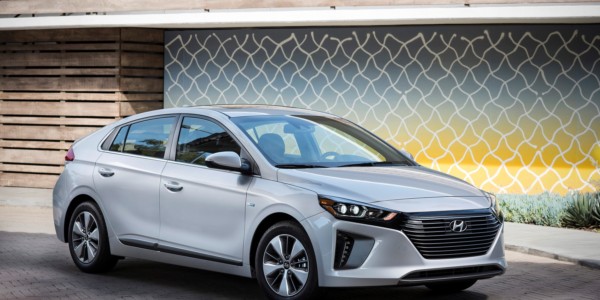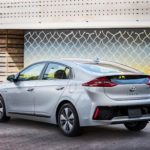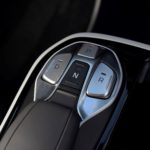By Jim Powell
After being released in 2017, it has taken the American public awhile to notice a new line-up of Hyundai small hatchbacks. The Ioniq [Eye-On-Ick] can be configured with three distinct powertrains including an all-electric, a hybrid, and now a plug-in hybrid gas/electric. Kia’s cousin 5-door SUV/Crossover shares this platform and is called Niro. Hyundai has forged ahead with a 2019 model year Ioniq, with new active safety features and remote charge management for the plug-in hybrid and electric models.
- 2017 IONIQ Plug-In Hybrid
- 2017 IONIQ Plug-In Hybrid
- 2017 IONIQ Plug-In Hybrid
One real criticism of the Ioniq layout is the poor viewing angle out the back window. I could see only the road just 75 feet behind the Ioniq due to the low rear window, and this could not be improved with seat adjustments. The real differences between the Ioniq and the Niro economy platforms are found in the rear quarter and cargo space; Niro through a lift gate and the Ioniq through a hatchback. The Niro’s rear visibility is marginally better while, oddly enough, the Ioniq has more cargo space behind the second seat with the hatchback design.
Hyundai and Kia both call these raised small hatchback/wagons “SUV’s.” For this category, one would expect an all-wheel-drive option which is not available on this small platform. In reality, this is almost false advertising because the Ioniq is not sporty or capable of off-road utility. None of these shortcomings can take away the fact that the Hyundai Ioniq is a very affordable and efficient hatchback which is actually fun-to-drive.
Hyundai has added more safety equipment for 2019, including the new Driver Attention Alert which uses a camera and algorithm to monitor the driver. This system alerts the driver when it “notices” a sleepy or non-reactive face. The car is watching you as you watch the road- freaky isn’t it? Included for 2019 is also standard High Beam Assist, Automatic Emergency Braking, Lane Keep Assist and Smart Cruise Control on the SEL trim level.
Our test 2018 Ioniq Plug-in Hybrid Electric Vehicle (PHEV) Limited came with an advanced infotainment system. Let me note first and foremost, how good the Apple CarPlay and Bluetooth systems work on this car. The integration was seamless, simple, and took 2 minutes to figure out. The clarity of the phone conversations had my administrative assistant guessing if I was in my office or on the road due to no background noise and crystal clear vocals, all while traveling at 75 miles per hour down a highway.
The instrument panel and center console are full of easy to use controls and knobs. Hyundai continues to group climate controls and infotainment controls separately, in addition to a great touch-screen. Also, there is now standard remote charging management for Plug in and Electric models via Hyundai’s Blue Link®. Think of this as the Korean version of General Motor’s On-Star.
The shift lever is not a confusing dial or joy stick, but rather a very intuitive shift lever, connected to a six-speed EcoShift® dual-clutch transmission (DCT) which is driven like a regular automatic. This is rare for a PHEV and adds to the fun-factor. All this familiar gear does not take away from the fuel efficiency of the Ioniq.
The Plug-in Hybrid uses a 1.6-liter direct-injected Atkinson-cycle four-cylinder engine (104 horsepower) and a 44.5 kW (60 horsepower) electric motor. This combination gives very solid acceleration up to 50 miles per hour. Easing off of the pedal means up to 27 miles on pure electric power and the ability to run on the plug-in battery pack in all-electric up to 75 MPH. There are ways for the driver to control all of these drive modes with an EV button but most of this just happens with the right foot.
I was able to drive my 2019 Ioniq Plug-in Hybrid up a grade from the Colorado River to the main highways of California, climbing 2,500 feet in elevation, on all-electric. This 29-mile range helps the Ioniq achieve an estimated 119 MPGe in EV mode and 52 MPG in hybrid mode. These are real numbers with an impressive performance.
Due to the 8.9 kWh lithium-ion polymer battery being stored under the rear seat, we could fold that seat down and carry all our gear (199.2 cubic feet) for a long weekend of boating and waterskiing. If the driver wants to have more options in performance, there are driving characteristic buttons for SPORT or ECO modes. The SPORT function holds lower gears longer and applies both gas and electric power to the front wheels. The ECO mode upshifts the DCT for optimized gear selection and controls all the electric components, like air conditioning, for the best fuel efficiency.
The Ioniq Plug-in Hybrid gets the great driving dynamics from a multi-link rear suspension system with dual lower aluminum control arms and good anti-sway bars up front. Then Hyundai engineered a low center of gravity and a very light unibody structure of high-strength steel, aluminum, and composites. This gives the Ioniq agile handling and a composed ride over rougher pavement.
Being focused on fuel conservation, Hyundai chose Michelin low-rolling-resistance tires on 17-inch wheels (Ioniq PHEV Limited) with great high-silica compounds. These tires are good for all-around performance but not very sticky for cornering or mountain driving. However, I found that driving the Ioniq at speeds over the legal limit was no problem, and I still averaged over 60 mpg for a week and more than 700 miles- with regular over-night charging.
Hybrid and Plug-in Hybrid models both have steering-wheel paddle shifters, but these are just for a little fun because this is not a sports car. The Hyundai Ioniq Plug-in Hybrid is a good looking economy vehicle that falls somewhere into a small wagon/crossover, designed for on-road use. Due to capable handling on tight city streets or runs on the open highway, Ioniq can work in the city or in the country. Best of all, prices for the 2018 Hyundai Ioniq Plug In Hybrid starts at $28,300 (Limited).
Finally, the Hyundai Ioniq is easy on the eyes, if not a little plain, with the Hyundai’s hexagonal grille and the vertical C-shaped LED daytime running lights. Most of the lights on the Ioniq Plug-in Hybrid are LED, including the bright headlamps. The front and middle sections of this car are stylish, without being overly sculpted. The driver’s seat is supportive for long drives, and the ingress and egress into all the seats is very easy. Now, if Hyundai would just address the rear window visibility….




